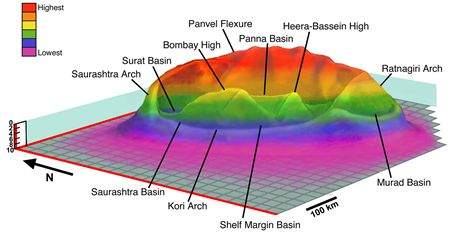A massive basin off the coast of India could be the world’s largest, multi-ringed crater – and the impact that caused it could have been the real cause of the mass dinosaur extinction 65 million years ago, say researchers.
Sankar Chatterjee of Texas Tech University took a close look at the Shiva basin, a submerged depression west of India that is intensely mined for its oil and gas resources.
“If we are right, this is the largest crater known on our planet,” Chatterjee said. “A bolide of this size, perhaps 40 kilometers – 25 miles – in diameter creates its own tectonics.”

By contrast, the object that struck the Yucatan Peninsula and is commonly thought to have killed the dinosaurs was between eight and ten kilometers wide.
If the team is right, the Shiva impact vaporized Earth’s crust at the point of collision, leaving nothing but ultra-hot mantle material to well up in its place. The impact could have ramped up the nearby Deccan Traps volcanic eruptions that covered much of western India.The team even suggests that the impact broke the Seychelles islands off of the Indian tectonic plate, and sent them drifting toward Africa.
There is strong evidence to back up the idea. Shiva’s outer rim forms a rough, faulted ring some 500km across, encircling a central peak, known as the Bombay High – about three miles tall from the ocean floor. Most of the crater lies submerged on India’s continental shelf, but where it does come ashore it is marked by tall cliffs, active faults and hot springs.
The impact appears to have sheared or destroyed much of the 30-mile-thick granite layer in the western coast of India.
The team hopes later this year to examine rocks drilled from the center of the putative crater for clues that would prove the strange basin was formed by a gigantic impact.
“Rocks from the bottom of the crater will tell us the telltale sign of the impact event from shattered and melted target rocks. And we want to see if there are breccias, shocked quartz, and an iridium anomaly,” Chatterjee said. Asteroids are rich in iridium, and such anomalies are thought of as the fingerprint of an impact.
Chatterjee will present his research at this month’s Annual Meeting of the Geological Society of America in Portland, Oregon.






